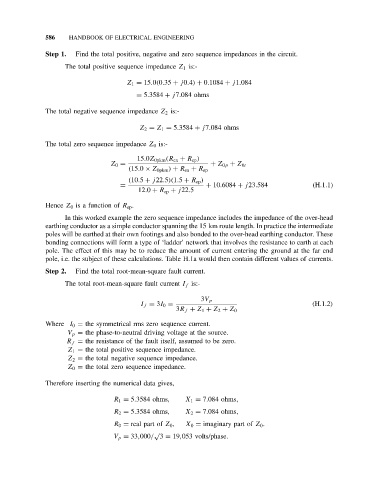Page 593 - Handbook of Electrical Engineering
P. 593
586 HANDBOOK OF ELECTRICAL ENGINEERING
Step 1. Find the total positive, negative and zero sequence impedances in the circuit.
The total positive sequence impedance Z 1 is:-
Z 1 = 15.0(0.35 + j0.4) + 0.1084 + j1.084
= 5.3584 + j7.084 ohms
The total negative sequence impedance Z 2 is:-
Z 2 = Z 1 = 5.3584 + j7.084 ohms
The total zero sequence impedance Z 0 is:-
15.0Z 0pkm (R en + R ep )
Z 0 = + Z 0p + Z 0t
(15.0 × Z 0pkm ) + R en + R ep
(10.5 + j22.5)(1.5 + R ep )
= + 10.6084 + j23.584 (H.1.1)
12.0 + R ep + j22.5
Hence Z 0 is a function of R ep .
In this worked example the zero sequence impedance includes the impedance of the over-head
earthing conductor as a simple conductor spanning the 15 km route length. In practice the intermediate
poles will be earthed at their own footings and also bonded to the over-head earthing conductor. These
bonding connections will form a type of ‘ladder’ network that involves the resistance to earth at each
pole. The effect of this may be to reduce the amount of current entering the ground at the far end
pole, i.e. the subject of these calculations. Table H.1a would then contain different values of currents.
Step 2. Find the total root-mean-square fault current.
The total root-mean-square fault current I f is:-
3V p
I f = 3I 0 = (H.1.2)
3R f + Z 1 + Z 2 + Z 0
Where I 0 = the symmetrical rms zero sequence current.
V p = the phase-to-neutral driving voltage at the source.
R f = the resistance of the fault itself, assumed to be zero.
Z 1 = the total positive sequence impedance.
Z 2 = the total negative sequence impedance.
Z 0 = the total zero sequence impedance.
Therefore inserting the numerical data gives,
R 1 = 5.3584 ohms, X 1 = 7.084 ohms,
R 2 = 5.3584 ohms, X 2 = 7.084 ohms,
R 0 = real part of Z 0 , X 0 = imaginary part of Z 0 .
√
V p = 33,000/ 3 = 19,053 volts/phase.

